 |
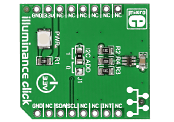
|
|
Illuminance click carries a TSL2561 light-to-digital converter with a sensor that's designed to mimic the way humans perceive light. This makes it ideal for applications where ambient lighting conditions have to be measured (backlight power-saving on LCD displays for example). The sensor has two photodiodes. One sensitive to full-spectrum light, the other to infrared. The visible-spectrum is then deduced by using a formula. Illuminance click communicates with the target board through mikroBUS I2C lines, and uses a 3.3V power supply. |
|
|
|
 |
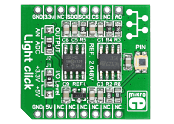
|
|
Light Click is the add-on board which features the PD15-22CTR8 PIN photodiode, providing an effective and easy way to measure ambient light intensity. It also features the MAX6106 voltage reference and MCP3201 ADC with SPI interface. Measured ambient light intensity is sent as an analog or digital signal to the main board microcontroller. Light Click communicates through mikroBUS SPI (MISO, SCK, CS) and AN lines. The PD15-22C-TR8 is a high photosensitive light sensor with fast response time. An SMD jumper allows the user to select whether the board will be powered with a 3.3V or 5V power supply. |
|
|
|
 |
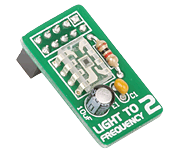
|
|
The Light to Frequency 2 Board enables you to connect your development board to a light-to-frequency converter. The board features a programmable light-to-frequency converter TSL230BR and is connected to a prototype device via an IDC10 connector. |
|
|
|
 |
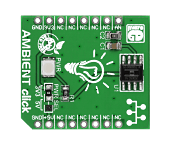
|
|
Ambient click carries the Melexis MLX75305 IC. It's a CMOS integrated optical sensor that consists of a photodiode, a transimpendance amplifier, and an output transistor. The chip converts ambient light intensity into a voltage, using the mikroBUS AN pin for communicating with the target board MCU. The board is designed to use either a 3.3V or a 5V power supply. |
|
|
|
 |
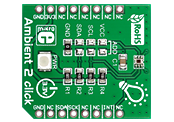
|
|
Ambient 2 click carries TI's OPT3001 Ambient Light sensor. This is a small (2mm x 2mm) single-chip lux meter that measures only the visible part of the light spectrum from any kind of source (mimicking the way humans see light). It does so by filtering out 99% of infrared light. The measurement range of Ambient 2 click is from 0.01 Lux to 83k lux, and a 23-bit resolution. Communication with the target MCU is done through mikroBUS I2C pins, with an additional INT pin which can be used for triggering wake-up events (offloading the MCU). |
|
|
|
 |
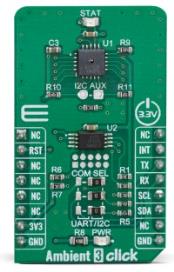
|
|
Ambient 3 Click is calibrated XYZ chromatic smart lighting director, providing the measurement data in digital format over the I2C interface. It utilizes the AS7225, a miniature light sensor with UART and I2C interfaces. Packed in a small casing, this sensor can provide calibrated for life nano-optic sensor providing direct CIE1931 XYZ and CIE 1976 u'v' coordinate mapping. A well-proven, integrated tristimulus sensing element designed to meet the XYZ standard observer response that mimic the human eye and is extremely stable over both operating temperature and time. The device contains a 16-bit integrating analog-to-digital converter, which integrates current from the photodiodes. To ensure the integrity of the data, upon completion of an integration cycle, results are transferred to double-buffered registers.
Ambient 3 click is supported by a mikroSDK compliant library, which includes functions that simplify software development. This Click board™ comes as a fully tested product, ready to be used on a system equipped with the mikroBUS™ socket.
|
|
|
|
 |
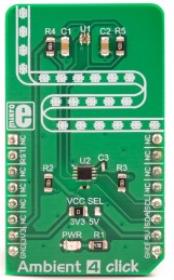
|
|
Ambient 4 click is a light intensity-sensing and measuring Click board™, which features an accurate, light-intensity sensor labeled as BH1721FVC, made by ROHM Corporation. It offers a high measurement accuracy in the range between 1x to 1.35x of the actual light intensity. The spectral response of the sensor is calibrated to closely match the spectral response of the human eye. Thanks to its high level of integration, the sensor requires a minimal number of external components, allowing the Click board™ to incorporate an additional level translating IC, ensuring a reliable data transfer over the industry-standard I2C interface. |
|
|
|
 |
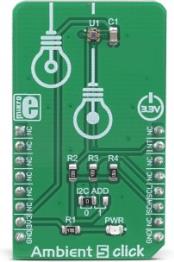
|
|
Ambient 5 click can sense the intensity of the ambient light, providing measurement data in a digital format, over the I2C interface. It utilizes the VEML6030, a miniature ambient light sensor (ALS) which occupies only 2x2 mm of space. Packed in a small transparent casing, this sensor offers a lot of features. Thanks to its 16-bit dynamic range, it can be used in very dim, but also in very bright lighting conditions. A Filtron™ technology provides spectral response close to a real human eye. The flicker noise rejection algorithm improves accuracy, while excellent thermal compensation ensures consistent readings.
Ambient 5 click is supported by a mikroSDK compliant library, which includes functions that simplify software development. This Click board™ comes as a fully tested product, ready to be used on a system equipped with the mikroBUS™ socket.
|
|
|
|
 |

|
|
Ambient 6 click can sense the intensity of the ambient light, providing the measurement data in digital format over the I2C interface. It utilizes the VEML7700, a miniature ambient light sensor (ALS) with I2C interface. Packed in a small transparent casing, this sensor can provide very accurate readings: thanks to a 16-bit dynamic range, it can be used in very dim and very bright lighting conditions. A well-proven Filtron™ technology allows response close to a real human eye, while the O-Trim™ technology allows for ALS tolerance less than 10%. The flicker noise rejection algorithm further improves accuracy, while excellent thermal compensation ensures consistency of the measurement results.
Ambient 6 click is supported by a mikroSDK compliant library, which includes functions that simplify software development. This Click board™ comes as a fully tested product, ready to be used on a system equipped with the mikroBUS™ socket.
|
|
|
|
 |
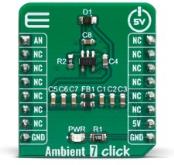
|
|
Ambient 7 Click is a light intensity-sensing and measuring Click board™, which features an accurate light-intensity sensor labeled as SFH 5701 A01, made by Osram Opto Semiconductors. It offers a high measurement accuracy in wide range of the actual light intensity. The spectral response of the sensor is calibrated to closely match the spectral response of the human eye. Thanks to its high level of integration, the sensor requires a minimal number of external components.
Ambient 7 click is supported by a mikroSDK compliant library, which includes functions that simplify software development. This Click board™ comes as a fully tested product, ready to be used on a system equipped with the mikroBUS™ socket.
|
|
|
|
 |

|
|
Ambient 8 click is equipped with the ambient light sensor (ALS) IC, providing measurements of the ambient light intensity in a digital format. It utilizes the LTR-329ALS-01, an ALS with the I2C interface. Packed in a small transparent ChipLED package, this sensor can provide very accurate readings: thanks to a 16-bit and resolution and high dynamic range, it can be used in both very dim and very bright lighting conditions: it can cover the range from 0.01 lx to 64 klx. It has an excellent IR filtering and two photo-sensing elements, allowing linear response over the whole range. The flicker noise rejection algorithm further improves accuracy, while excellent thermal compensation ensures consistency of the measurement results.
Ambient 8 click is supported by a mikroSDK compliant library, which includes functions that simplify software development. This Click board™ comes as a fully tested product, ready to be used on a system equipped with the mikroBUS™ socket.
|
|
|
|
 |
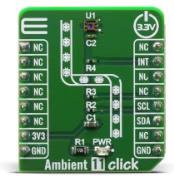
|
|
The Ambient 11 Click is a Click board™ equipped with the VEML6035, a low power, high sensitivity, I2C ambient light sensor from Vishay Semiconductors. Because of the possibilities its features offer, the Ambient 11 Click can be used as an ambient light sensor for mobile devices, industrial lighting operation, and as an optical switch for consumer, computing and industrial devices and displays.
Ambient 11 Click is supported by a mikroSDK compliant library, which includes functions that simplify software development. This Click board™ comes as a fully tested product, ready to be used on a system equipped with the mikroBUS™ socket.
|
|
|
|
 |

|
|
Design devices that warn you of excesive ultraviolet radiation levels with UV click. This click boards carries the ML8511 IC that is sensitive to UV-A (365-315 nm) and UV-B (315-280 nm) rays. The board can output either analog or digital signals proportional to the amount of UV exposure. To bypass the onboard MCP3201 ADC and get an analog output, solder the A/D SEL jumper in the AN position. Depending on the position of the jumper, UV click communicates with the target board either through mikroBUS SPI (CS, SCK, MISO) or AN lines; additionally, the sensor can be enabled or disabled from the MCU through the RST (EN) pin. When handling UV click, be careful not to press or rub the sensitive surface of the ML8511 sensor IC. UV click uses a 3.3V power supply only. |
|
|
|
 |
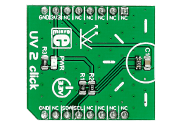
|
|
UV 2 click is a mikroBUS™ add-on board with a VEML6075 UVA and UVB light sensor. VEML6075 is a CMOS chip that incorporates a photodiode, amplifiers, and analog/digital circuits.
With UV 2 click, Solar ultraviolet light intensity is converted to 16-bit digital values. UVA and UVB are in separate channels. To keep a stable output in changing temperature conditions, the chip has temperature compensation capabilities. This ensures reliable performance under long term UV exposure.
The sensor has a specified UVA sensitivity of 365 nm and UVB sensitivity of 315 nm
The board communicates with the target MCU through the mikroBUS™ I2C interface. Designed to use a 3.3 power supply only. |
|
|
|
 |
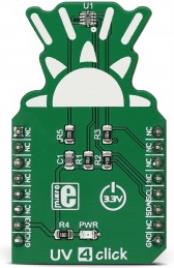
|
|
UV 4 click is a powerful Ultra Violet (UV) sensing device and Ambient Light Sensor (ALS) Click board™, featuring a sensor with a very wide dynamic range of detectable light intensity, across two ADC range settings. The UV diodes are matched to CIE erythema action spectrum, allowing a very accurate calculation of the UV index. The UV Index is standardized by the World Health Organization and it represents the strength of sunburn-producing (UV) radiation. |
|
|
|
 |
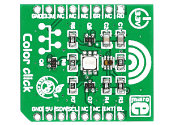
|
|
Color click is a compact and easy solution for adding color sensing to your design. It features a TCS3471 color light sensor as well as an RGB LED diode. The TCS3471 features red, green, blue, and clear light sensing (RGBC) that detects light intensity under a variety of lighting conditions and through a variety of attenuation materials. An RGB LED is provided to help you illuminate the objects if no other light source is available. Color click communicates with the target board microcontroller via mikroBUS I2C (SDA, SCL) and INT lines. The board is designed to use 3.3V power supply only. |
|
|
|
 |
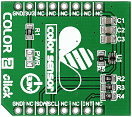
|
|
Color 2 click carries the ISL29125 RGB color light sensor. It detects red, green and blue in a variety of lighting conditions, outputting 16-bit resolution data in a 5.7 m lux -10,000 lux measurement. Both the range and output resolution are selectable (narrower vs wider bandwidth, 12 vs 16 bit). The sensor also incorporates an IR blocking filter, allowing Color 2 click to work even under a dark glass cover. The integrated ADC also rejects 50Hz and 60Hz flicker from artificial light sources. The board communicates with the target MCU through the mikroBUS I2C interface (SCL and SDA pins). A programmable interrupt pin is also available. The board is designed to use a 3.3V power supply only. |
|
|
|
 |
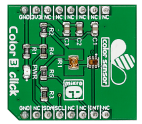
|
|
Color 3 click is a mikroBUS add-on board with a TCS3771 color sensor (also known as a light-to-digital converter) and a narrow beam Infrared LED. The circuit can also function as a proximity sensor.
TCS3771 is a RGBC sensor: it can detect Red, Green, Blue and clear light. The IC performs well under a variety of lighting conditions. For example, it can be covered with different attenuation materials.
As a proximity sensor it has a large dynamic range of operation. It can take short distance measurements behind dark glass; or it can be configured for longer distance measurement, for example, human presence detection in front of monitors or laptops.
For power-saving, TCS3771 has an internal state machine that can put the device into a low power mode between successive RGBC and proximity measurements.
TCS3771 is also fast enough to give off proximity information at a high rate of repetition. This makes it useful for proximity detection in portable devices (such as a phone coming near to a speaker’s ear).
Color 3 click communicates with the target MCU through the mikroBUS I2C interface, with additional functionality provided by an INT pin. Designed to use a 3.3 power supply only. |
|
|
|
 |
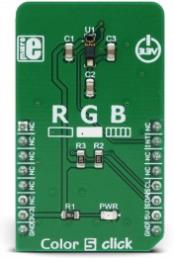
|
|
Color 5 click is a color sensing Click board™, which utilizes the P12347-01CT, integrated color sensing device. This sensor is able to sense red (R), green (G), and blue (B) component of the light, providing measurement via the I2C interface. Besides sensing R, G and B components, there is an IR sensor too, allowing this Click board™ to sense an intensity of the infra-red spectrum. In addition, this sensor is equipped with 3 LEDs, one for each color component of the white light: red, green and blue LEDs are embedded into the sensor itself. Combination of photo-sensing and photoemission elements allows for yet another feature of this sensor - a proximity sensing. |
|
|
|
 |
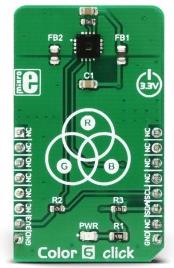
|
|
Color 6 click is a very accurate color sensing Click board™ which features the AS73211, an XYZ true color sensor from ams. This company has developed a proprietary JENCOLOR™ filter technology, which ensures compliance to the CIE 1931/DIN 5033 standard (human eye response), providing an accurate XYZ color space response. The low noise 24bit ADCs ensure the highest dynamic range available on market, with the irradiance responsivity per countdown to 0.0005 pW/cm². This sensor offers a fast I2C interface for the communication with the host MCU. |
|
|
|
 |
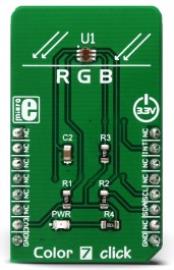
|
|
Color 7 click is a very accurate color sensing Click board™ which features the TCS3472 color light to digital converter with IR filter, from ams. It contains a 3x4 matrix of photosensitive elements, which can sense red, green, blue and clear light component. Additional IR resistive coating reduces the influence of the IR component of the light spectrum. Four low noise 16bit ADCs ensure the high dynamic range, making this sensor suitable to be used behind dark glass. This sensor offers a fast I2C interface for the communication with the host MCU. Ability to measure light without the influence of the IR makes this device a good choice for Ambient Light Sensing (ALS). |
|
|
|
 |
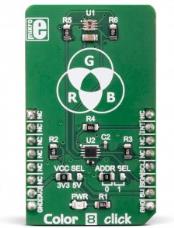
|
|
Color 8 click is a color-sensing Click board™, a part of our sensor Click board™ line. Sensing the color by utilizing ROHM's BH1749NUC, an integrated color sensor IC, it comes in the package which also includes the mikroSDK™ software, a library with all the functions. The Click board™ comes as a fully tested and approved prototype, making it a reliable device ready to use on the development board. It is perfect for sensing the subtle light changes, as it is equipped not only with the red, green, and blue (RGB) but also the infra-red sensor, allowing a very accurate measurement of the subtlest changes in light.
Color 8 Click board™ is an ideal solution for LED lighting color management, display color correction on mobile devices, TFT display color correction, and other similar applications that require accurate color sensing.
|
|
|
|
 |
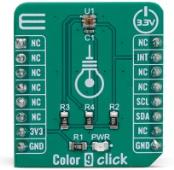
|
|
Color 9 Click is a very accurate color sensing Click board™ which features the APDS-9250, IR and ambient light sensor, from Broadcom. It contains a specially designed matrix of photosensitive elements, which can sense red, green, blue and IR component. Four low noise 18bit ADCs ensure the high dynamic range, making this sensor suitable to be used behind dark glass. This sensor offers a fast I2C interface for the communication with the host MCU. It is perfect for sensing the subtle light changes, as it is equipped not only with the red, green, and blue (RGB) but also the infra-red sensor, allowing a very accurate measurement of the subtlest changes in light.
Color 9 click board™ is supported by a mikroSDK compliant library, which includes functions that simplify software development. This Click board™ comes as a fully tested product, ready to be used on a system equipped with the mikroBUS™ socket.
|
|
|
|
 |
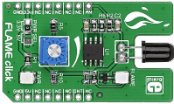
|
|
Flame click is a fire detection solution. It carries a PT334-6B silicon phototransistor that's covered in black epoxy and therefore sensitive only to infrared light. To use it as a fire alarm, set up the exact detection threshold through the onboard potentiometer (once reached, the click will send an interrupt to the target board MCU through the mikroBUS INT pin). Othewise the sensor can also output a continuous analog signal through the mikroBUS AN pin. Flame click can use both a 3.3V or a 5V power supply. |
|
|
|
 |
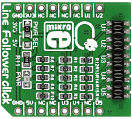
|
|
Line Follower click carries an array of five QRE1113 miniature reflective object sensors. As the name implies, Line Follower click is best used for line following robots and cars. Each one of the QRE1113 sensors consist of an infrared transmitter and infrared receiver. For communicating with the target MCU, the individual sensors have their own separate digital outputs, each one routed through a single mikroBUS pin: OUT1, OUT2, OUT3, OUT4 and OUT5 (in place of default mikroBUS pins RST, AN, PWM, TX and RX, respectively). Line Follower click is designed to use either a 3.3V or a 5V power supply. |
|
|
|
 |

|
|
MCP1664 click contains 4 high-power white LEDs. It carries the MCP1664, a high-voltage step-up LED driver from Microchip. MCP1664 click is designed to run on either 3.3V or 5V power supply. It communicates with the target board microcontroller over the PWM pin on the mikroBUS™ line. |
|
|
|
 |
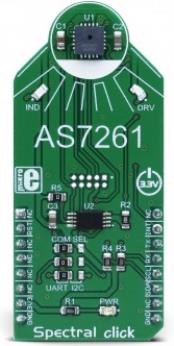
|
|
An XYZ Chromatic White Color Sensor
Spectral click is a multispectral light sensing device, which uses the state-of-the-art sensor IC for a very accurate chromatic white color sensing. Spectral click provides a direct reading of the XYZ color coordinates, consistent with the CIE 1931 2° Standard Observer color coordinates. It provides mapping of the XYZ coordinates to the x, y (Y) coordinates of the two-dimensional color gamut, and it scales them to the CIE 1976 u'v' coordinate system. This click board also provides accurate Correlated Color Temperature (CCT) measurements and color point deviation from the black body curve for white light color, in u'v' coordinate system. Additionally, Spectral click features the Near-IR (NIR) wavelengths sensing channel, as well as two programmable LED channels with a constant current. |
|
|
|
 |
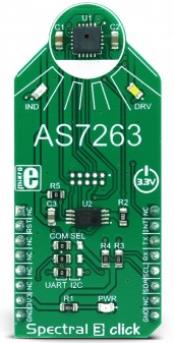
|
|
Spectral 3 click is a multispectral sensing device, which uses the state-of-the-art sensor IC for a very accurate near-IR (NIR) sensing. The sensor on the Spectral 3 click provides multi-spectral sensing in the NIR wavelengths from approximately 610nm to 860nm with the full width at half maximum (FWHM) of 20nm. Spectral 3 click provides a direct reading of the six different channels with the 16bit precision, as well as the calibrated reading, that gives 32bit float values with an 8bit biased exponent and a 23bit fraction part, processed through the Spectral ID engine. The sensor also integrates two programmable LED channels with constant current drivers, useful for indication and for providing the backlight for the measured color object. |
|
|
|
 |
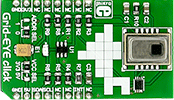
|
|
Grid-EYE click is a 8x8 thermal array sensor-detector that carries the AMG8853 infrared array sensor from Panasonic. 64 individual thermal sensors build an image on a display. The detecting distance is 5m. |
|
|
|
 |
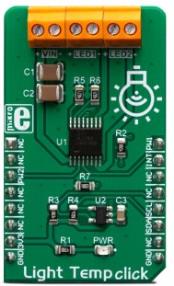
|
|
Light Temp Click is a dual-channel LED driver, designed to be used in tunable Smart Connected Lighting (SCL) applications. It is based on the AL1782, a dual-channel PWM dimmable linear LED driver. By utilizing a high-frequency E-flicker free technology with Deep Dimming capability, it can be used in both single-channel dimmable white and dual-channel tunable white SCL applications. The AL1782 IC features the Adaptive Thermal Management scheme, reducing power dissipation. It also integrates an abundance of protection features for increased reliability: undervoltage, open or short circuit at the output, and thermal protection.
Light Temp Click is supported by a mikroSDK compliant library, which includes functions that simplify software development. This Click board™ comes as a fully tested product, ready to be used on a system equipped with the mikroBUS™ socket.
|
|
|
|
 |
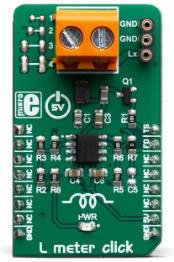
|
|
L meter click is a compact and accurate Click board™, capable of measuring and monitoring the inductance of the external component. The board can be used to measure a wide range of inductance. The design is based on a single high-speed voltage comparator LM311 by which the frequency of the oscillating LC circuit is measured and, based on the known value of capacitance, measures the unknown inductance value. L meter click can be used to measure inductance as well as to check the accuracy and precision of the coil.
L meter click is supported by a mikroSDK compliant library, which includes functions that simplify software development. This Click board™ comes as a fully tested product, ready to be used on a system equipped with the mikroBUS™ socket.
|
|
|
|
 |
|

